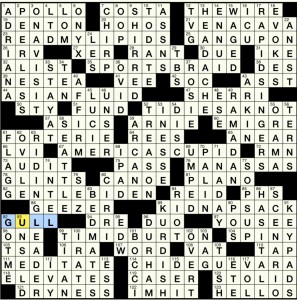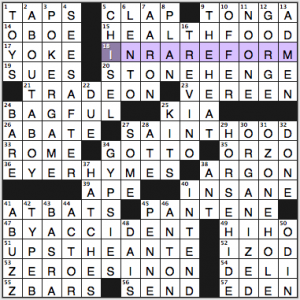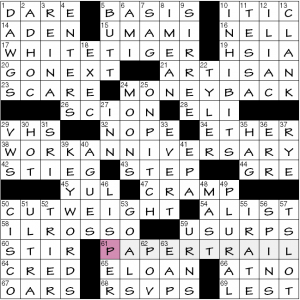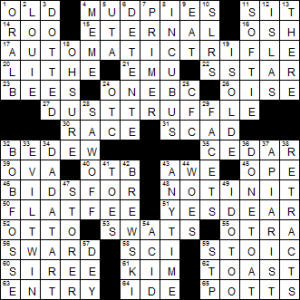NYT 4:30 (Amy)
LAT 5:52 (Gareth)
CS tk (Ade)
CHE 8:16 (pannonica)
WSJ (Friday) 13:23 (Derek)
Patrick Berry’s New York Times crossword
This puzzle? Is soopa-smooth. So much zippy stuff in it, too. Here are entries and clues I was particularly taken with:
- 18a. [Doing particularly well], IN RARE FORM.
- 20a. [Site of an annual British music festival], STONEHENGE. Manhattanhenge is Friday (when the rising and setting sun is centered relative to the east/west streets); the next Chicagohenge is September 25 (our streets are not at a weird angle like New York’s).
- 27a. [Judas never attained it], SAINTHOOD. Imagining a “Saint Judas Cathedral.”
- 36a. [Four-hour tour features?], EYE RHYMES. They look like they rhyme, all ending with -our, but don’t because the English language is a ludicrous beast.
- 51a. [Increases risk and reward], UPS THE ANTE. Solid phrase. We get UPS and ANTE in puzzles all the time, but not this phrase.
- 2d. [1998 coming-of-age novel by Nick Hornby], ABOUT A BOY. Also a movie, and then a very different TV series.
- 3d. [Oscar Madison’s weekly event], POKER GAME. I wonder if that will figure into the new TV remake of The Odd Couple.
- 9d. [2013 Sandra Bullock/Melissa McCarthy comedy], THE HEAT. I enjoyed the movie, and just this week read this blog post in which a fat woman greatly appreciated the absence of weight mockery in the movie.
- 13d. [Commercial manufacturers], ADMEN. Interesting clue. You don’t think of making TV commercials as “manufacturing,” but it works. (Still don’t like the gendering of “admen.”)
- 31d. [Atmospheric problem], OZONE HOLE.
- 37d. [Sub entries], HATCHES. Took me a while to understand how the clue fit the answer—submarine hatches.
Did not know: 34d. [Broadway chorus dancers, informally], GYPSIES. Also, the use of “prefers” in the clue for 19a. [Prefers charges against], SUES—was not familiar with that formal usage of “prefer” to mean “submit.”
Anything give you trouble in this one? 4.5 stars from me, for all the crunchy fill combined with the typical Berry smoothness. (Almost wrote “Berry smoothie.” Do people call his puzzles that?)
Daniel Landman’s Chronicle of Higher Education crossword, “Sheaf Engineer” — pannonica’s write-up
Eight sheets don’t quite make a sheaf, as per the punned title (from “chief”) but there is a sort of paper engineering going on in the puzzle.
- 61a. [What an auditor examines, or what either part of the answer to each of the starred clues can be] PAPER TRAIL. That is, each element of the answers can follow the word “paper” to make a new word or phrase.
- 17a. [*Cat that’s usually the result of zoo inbreeding] WHITE TIGER (paper white,, paper tiger). White paper is also a thing, a much more common one than paper white, but that isn’t relevant here.
- 24a. [*Rebate] MONEY BACK (paper money, paperback).
- 38a. [*Occasion for celebrating with colleagues] WORK ANNIVERSARY (paperwork, paper anniversary).
- 50a. [*Prepare to change classes in wrestling, maybe] CUT WEIGHT (paper cut, paperweight). This entry seems less common, at least to me, than the others.
Run-of-the-mill sort of theme, but made well.
Had trouble completing the grid correctly, the two top corners being especially tricky. In the northwest, ignorance of University of Georgia ‘DAWGS‘ was a liability, while a recondite non-committee clue for AD HOC [Like some hypotheses], difficulty deriving REINA from [Castile’s “Juana la Loca,” for one], hesitation in putting GO before ––NEXT [Follow], plus DARE and ENTERS not being very easily clued all conspired to create recalcitrance.
Over in the northeast, the problem was more one of inattention. Naturally, I filled in -ITIS for 10a [Suffix with laryng-]. And so 19a [Earliest recorded Chinese dynasty] HSI– was completed as HSIU as I entered SLUNK for 13-down without reading the clue. Ah, but that is not the [Sound effect in Verdi’s “Anvil Chorus”], not at all. That would be CLANK, entailing the less-common laryngITIC and the correct HSIA Dynasty.
- Quite a lot of abbrevs. GRE, AT NO, POV, EAP, EPA, plurals RSVPS and VWS,
- Don’t recall encountering IL ROSSO aka Rosso Fiorentino aka Giovanni Battista di Jacopo in my art history classes. 58a [Florentine Mannerist painter nicknamed for his carrot top]. Other Mannerists include Tintoretto, Bronzino, El Greco, Cellini, and Arcimboldo.
- Tough, clever-flavored clues for the paired 9d and 46d. [Word often addressed to Bob] SIRREE, [One who won’t traverse Mississippi?] LISPER.
- Another clue that I couldn’t make head or tail of and only understood in retrospect: 45a [Pharaoh to Charlton’s Moses] YUL. I just wasn’t making the connections.
- 50d [Tech giant whose logo approximates the Golden Gate Bridge] CISCO. This I didn’t know but am happy to have learned.
Good puzzle. More difficult than usual, as I’ve already noted.
 Randolph Ross’s Wall Street Journal crossword, “Identification Required” – Derek’s write-up
Randolph Ross’s Wall Street Journal crossword, “Identification Required” – Derek’s write-up
Always liked Randy Ross’s puzzles. This one is no exception. A whopping 11 theme entries, and lots of lively fill. At least nothing that annoyed me. Theme is clever to boot: the title, “Identification Required,” hints at what is happening. Add the letters “ID” to several phrases to get new, amusing phrases. Here they are:
- 23A [Request to a cardiologist for a blood test?] READ MY LIPIDS
- 35A [Hairstyle for many a female gymnast?] SPORTS BRAID
- 44A [Misload soup or green tea?] ASIAN FLUID
- 52A [Makes one’s granny look better?] TIDIES A KNOT
- 67A [U. S. Matchmaker?] AMERICA’S CUPID
- 82A [Vice president who doesn’t play rough?] GENTLE BIDEN
- 89A [Bag for the ransom money?] KIDNAPSACK
- 99A [Meeker of Taylor’s husbands?] TIMID BURTON (Minor complaint here; clue shouldn’t reference Richard Burton. [Reserved “Beetlejuice” director?] seems better. But still solvable…)
- 114A [Tell off a revolutionary?] CHIDE GUEVARA
- 17D [Performers would work prestissimo?] RAPID SINGERS
- 63D [Head of the Hells Angels?] RIDING LEADER
Most of these made me chuckle, which is what you want. High quality stuff. Some notes:
- 19A [Sleep Dr.?] DENTON – After googling, I realize I slept in these…
- 26A [Robbins of Baskin-Robbins] IRV– Gettable. Goes in the learn-somethkng-new-everyday category.
- 61A [City across the border from Buffalo] FORT ERIE – Since TORONTO didn’t fit, this was also inferable. Never heard of it, though.
- 88A [Crotchety fellow] GEEZER – What I’m turning into…
- 119A [Robbers advance man] CASER – Who says this?? “Butch, you be the CASER…” Still gettable…..
- 1D [Dreams role on “The Sopranos”] ADRIANA – A reference to actress Drea de Matteo. Actually never seen the show. Will likely binge watch someday.
- 45D [“A Tale of Two Cities” heroine] LUCIE – Much better clue than a reference to Port St. Lucie, FL.
- 58D [Where Starbucks started] SEATTLE – Heading there in about a month!
- 61D [Fannie of film and fiction] FLAGG – Wasn’t she a regular on Match Game? I’m showing my age again….
- 70D [“Going Rogue” author] PALIN – Ah, the once-golden hope for the Republican Party…maybe she will join the other 57 Republicans running for the 2016 nomination?
- 92D [“I haven’t the foggiest!”] GOT ME – I usually add the word “You” in front of this phrase.
- 93D [Wes in the Basketball Hall of Fame] UNSELD – I realize this may not be an easy clue for most, but it was a gimme for me. Maybe for longtime Knicks fans, too!
Solid all around. 4.5 stars from me!
John Lampkin’s LA Times crossword – Gareth’s review
This puzzle is offbeat in a number of ways. The first thing most of us noticed(?) is the atypical left/right symmetry. This is done for reasons of convenience in terms of theme answer length, as the theme entries don’t make up a symmetrical set: 15, 11, 8, 8 – 42 squares. The whole puzzle has the feel of a slightly blacked-in themeless, but with a kooky theme: [Self-preparing dessert?], AUTOMATICTRIFLE; [Dry, powdery dessert?], DUSTTRUFFLE; [Surreal dessert?], DADATART. I had no idea what a dust ruffle (the base phrase) was, but it turns out it’s what’s called a frill in South African English (See one of our biggest local linenware shops). Some supplementary googling suggests dust ruffle is used in US English, bedskirt is US and UK English and valance mostly UK. Bedskirt is the only one that sounds familiar to me! I think we all understand the conceit? Add a T to a phrase and create a wacky phrase with a dessert in it. Just three theme answers of variable length feels a tad underdone, but I’m suspecting this is a highly (too?) restrictive theme idea.
We have, as noted, a low theme density, but also a low word count. Left/right grids are also more difficult to balance adequately. There are lot of longer non-theme answers, many good to excellent, but with compromises in the shorter answers.
Bullets:
- [Kids’ rainy day projects], MUDPIES. Good as an answer in isolation. Apt over here, as we’re starting a week’s worth of constant drizzle (hello winter!). Can either be seen as a bonus answer or one interfering with the theme, depending on one’s outlook; this is especially so given DUSTTRUFFLE.
- [Red giant], SSTAR. This type of answer that just feels desperate.
 [Nocturnal demonic visitor], INCUBUS. Who doesn’t like a bit of mythological rape in their crosswords?
[Nocturnal demonic visitor], INCUBUS. Who doesn’t like a bit of mythological rape in their crosswords?- [Pushover], SOFTIE. Fun word, but not enough to counteract SSTAR.
- [Wagnerian soprano], ISOLDE. I wish her name wasn’t spelt so many darn ways!
- [Choreographer with nine Tonys], BOBFOSSE. Full name.
- [Facetious scapegoat], EVILTWIN. Fun clue/answer angle!
- [Acorn woodpecker, e.g.], STORER. Clunky answer and weird clue, but it all comes out OK in the end, because how fascinating is this behaviour?
2.5 Stars. I appreciate that this puzzle has taken risks and approached crosswords from a different angle, but I don’t think the whole thing quite lands.
Gareth.
P.S., John sent one of his many nature photographs, one of BEES, but the attachment seems to have fallen off… This may be updated later.

I’ve attached a bee collecting pollen, Chelostoma philadelphi. I have a very old Mock Orange shrub on my property. Every year about this time my wife and I wait for it to open so we can stand there and sniff for ten minutes or so. Seriously. A few years ago I noticed this bee and discovered that it is closely associated with Mock Orange whose genus is Philadelphus, hence the name for the bee. Every year this bee shows up right on schedule and I’ve never seen it anywhere else. It’s one of the leaf-cutter bees that cuts circles out of leaves to build cells inside of old beetle holes and such. It packs pollen inside each cell and lays an egg.



Four doesn’t rhyme with tour? So “four-hour tour” features an eye rhyme in the singular and the clue’s phrasing things poetically?
Strike poetically as I confused things. “Four-hour tour” has an eye rhyme not eye rhymes, no? Thanks.
four/hour
four/tour
hour/tour
Each pair is an eye rhyme. Together, eye rhymes.
“Four” and “tour” don’t rhyme in standard American English.
This is me. Martin H. I somehow used wrong email.
It’s hard enough for us to tell one Martin from the other. Now they can’t do it, themselves. Seesh…
Martin, that’s why it’s called an eye rhyme. It’s not a normal rhyme. I didn’t get it, and when I looked here I thought it was a joke. The phrase has plenty of sources, though.
I’m pretty sure that these words do not rhyme in the normal way (by sound) for most U.S. English speakers. But if anyone does rhyme any of them (see below), it doesn’t disqualify the words as eye rhymes, though there wouldn’t be much of a point to calling them that.
Just a few days ago I unearthed an old electronic gadget called the Franklin Language Master (copyright 1984) which allows you to type in an English word and then press a button to hear the word pronounced. It saved me from objecting here to WEREWOLF as having a first syllable sounding like wear, where, etc… Would have said it rhymed with HERE.
I doubt if you can find one today — too bad, it’s very handy!
Pretty easy going for a Friday, but I thought it wasn’t as smooth as your usual PB. STONEHENGE hasn’t been the site of an annual music festival for 30 years (because those darn weed-smoking kids were tearing the place up), but the clue seems to suggest it still happens.
SEESAFTER doesn’t sound to me like a natural phrase.
A CHISEL doesn’t have a ‘bezel’ — surely that’s a mistake for bevel. Unless you like your chisels bejeweled.
With the exception of SEESAFTER, the long answers were great. ABOUTABOY is a very good movie. There’s a scene at the beginning where Hugh Grant is handed a baby (his sister’s? can’t remember) and holds it at arm’s length as if it were a chunk of radioactive waste. Very funny. Whatever happened to Hugh Grant?
Wikipedia disagrees with you about BEZEL.
Are you referring to the wiktionary entry for bezel? It indeed claims that the word can mean the sloping edge of a cutting tool.
But I don’t buy that. MW11 offers no such definition. I know which reference I prefer.
The OED says the same thing– in fact, it gives
1. A slope, a sloping edge or face: esp. that of a chisel or other cutting tool (commonly basil.)
as the original, older meaning with citations going back to the 17th century.
I’m surprised. I’ve never heard of the cutting edge of a chisel referred to as anything but a bevel. The etymology of the two words seems to be quite different, although (in the case of bevel) uncertain.
Oxford’s definition of “chisel” does include the phrase “beveled cutting handle” and not “bezel.”
People setting cabochon stones in metal ring bezels have wondered about the confusion between the words. It goes both ways! http://andy321.proboards.com/thread/52042?page=1
Merriam Webster Unabridged – bezel 1: a sloping edge or face especially on a cutting tool — called also basil
I’m not sure why you would prefer an abridged dictionary to other references but, to further the mystery, the unabridged Merriam-Webster’s includes the chisel meaning of bezel as the first sense. Why that didn’t make the cut to the desk dictionary is anyone’s guess.
because it’s archaic, maybe?
It’s not archaic. “Bevel” on a chisel is ambiguous. Many chisels have side bevels and referring to the cutting angle as the bezel makes it clear which face you’re talking about.
Fine woodworkers also disagree about BEZEL. The working end of a good chisel actually forms two angles with the back. The bevel is the obvious, acute angle you see, 1/2″+ in length. The bezel, or a “micro bevel” is at the very tip, about 1/32-1/16″, forming an angle with the back 10+ degrees steeper than does the bevel. This gives a stronger tip and less metal to remove when you hone the edge. The low angle of the major bevel reduces interference between the wood and the tool.
Of course, none of this applies to tools found in the big box stores. They just sell almost sharp thingies.
I use “bevel” to refer to the sides (see above). I sharpen Japanese kitchen knives with a microbevel but chisels flat. Thankfully I don’t have to worry about microbezels.
“See after” and “see to” were both fairly common phrases where I grew up – rural Wisconsin. Don’t know if it’s Midwestern or a rural thing.
David L, Hugh Grant was at the French Open this week, but I don’t think that’s what you mean.
The SW quadrant of the NYT was hard to finish off– TYPEB was the key entry for me, I had to keep reminding myself that it couldn’t be HYPER. Once I got that, the rest of the quadrant fell rapidly into place.
Also, in my dialect, four, hour, and tour all have different vowel sounds and definitely don’t rhyme.
“Gypsies” for chorus dancers was unfamiliar to both Amy and Rex, which surprised me. I didn’t think of that as specialized knowledge and I don’t think of myself as all that specialized. My (amateur) musical theater days are long behind me. Maybe it’s the hours and hours of watching Gene Kelly and Astaire and Rodgers and “That’s Entertainment” and then reliving all of that with my daughter. Anyway, I’m always surprised when I know a word they don’t know.
I loved this puzzle. Definitely that Berry smoothie-ness and lots of fun. The bottom half took longer to fall than the top half because EYERHYMES did not come easily. I didn’t actually think about the sounds of the words themselves until I read the comments and I’ve been sitting here mumbling “four” and “tour” for a while. To me, they sound the same.
“Fore” and “too-er” and “ow-er,” all distinct for me. What do your “four” and “tour” sound like? “Fore” and “tore”? “Foo-er” and “too-er”?
I’ve occasionally heard tour pronounced as “tore,” also sometimes something like “tow-er” – but both pretty rare.
For those who think they pronounce “tour” and “four” similarly, try this: say “four-door” and then “four-tour.” Alternate between the two phrases.
When I do it I feel the configuration change of my lips and tongue for “tour” compared to the other three phonemes. It’s slightly more “oo”-ier.
Of course, this test isn’t for the “too-er” people.
Yep. “Fore” and “tore”. Tried Martin’s test and didn’t notice anything. I’ve never even thought about this before and now I am obsessed with it. I may put the words up on the board in our conference room and see how my team pronounces them.
May I say, as someone who isn’t a native English speaker, you guys are making me feel so much better. I always wonder whether there’s a secret understanding of American pronunciation that’s bestowed during a critical developmental period that I simply missed and is now irretrievable.
Apparently, not. Or we all missed it.
Jenny, I saw the play Gypsy, but somehow never learned this term, or understood the meaning of the title.
I don’t think it has anything to do with Gypsy Rose Lee. Back in the old days (see previous reference to MGM musicals), dancers were a tight-knight tribe that went from show to show and often on the road, together. Gypsies. A traveling band.
Derek-
Welcome in advance to Seattle! Let me know if you want any suggestions on places to eat, things to do, etc. Maybe we can meet up for a drink or something.
Jeff
Where are you located? I’m way out in Morton. Do you know where that is?
No idea! Just looked it up — wow, you’re way out past Olympia.
So, where are you?
Sounds great!
Maybe I’m the only one bothered by this, but I still am baffled by “KIA” clued as “soul producer.” I’m familiar with the Egyptian spiritual term “ka”–but if this is a reference to that, it’s quite obscure. Or are we talking about KIA (killed in action), in which case the clue seems kind of tasteless, and not even accurate. Anyone have an explanation for this?
Otherwise, a strong puzzle, though like everyone else, we found “eyerhyme” and “gypsies” and “ape” a challenge.
Kia manufactures an automobile called the Soul.
Thanks, Gary R. Those product name clues always trip me up.
I am surprised at the low marks for John Lampkin’s effort which I found to be quite charming, highlighted by the use of the visual T in the middle of his grid, which for me more than offset any questions about the symmetry. I am very fond of the trend to include the picture of the grid in the development of a puzzle. I certainly liked the long non-themers and did not see the short fill as being bad.
Gareth’s 2.5 seems a bit harsh, but the overall rating a little north of 3 seems fair. The theme wasn’t all that exciting, but I thought the fill was pretty good.
I was slowed down a bit in the southwest because I was convinced that 34-D was DAliTART. I’m pretty sure Salvador Dali was a Surrealist. Is Dadaism the same as Surrealism?
NO! Dada is a movement that preceded Surrealism. It may have been an influencing factor and, in some ways overlaps, but most artists are usually grouped separately. Dali is considered a Surrealist, although Anton Breton might disagree. Breton is to Surrealism as Arp is to Dada. Breton was a rigorous and colorful leader of the Paris Surrealists. He had a falling out with Dali over the latter’s communist affiliation.
On an essay question asking “What is Dada?”, I answered, “Dada is not.” I got a full grade for it, as well as a laudatory remark from the teacher, beginning with, “Yes it is!!!”.
I too liked the LAT’s T-dessert puzzle, very innovative! How many other combos are there? I can’t think of any more… But the WSJ with the inserted ID was a real chuckle and it was hard to choose a favorite theme answer among all that were included!
“Berry Smoothie” is awesome.